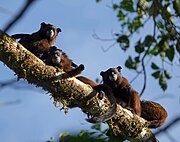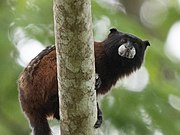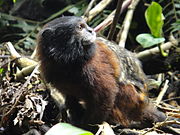Biology:Saddle-back tamarin
| Saddle-back tamarins | |
|---|---|

| |
| Weddell's saddle-back tamarin | |
| Scientific classification | |
| Domain: | Eukaryota |
| Kingdom: | Animalia |
| Phylum: | Chordata |
| Class: | Mammalia |
| Order: | Primates |
| Suborder: | Haplorhini |
| Infraorder: | Simiiformes |
| Family: | Callitrichidae |
| Genus: | Leontocebus Wagner, 1840 |
| Type species | |
| Leontocebus fuscus Lesson, 1840
| |
| Species | |
|
10 species, see text | |
| Synonyms | |
| |
The saddle-back tamarins are squirrel-sized New World monkeys from the family Callitrichidae in the genus or subgenus Leontocebus. They were split from the tamarin genus Saguinus based on genetic data and on the fact that saddle-back tamarins are sympatric with members of Saguinus to a greater extent than would be expected from two members of the same genus.[1][2] However, this argument can be circular, as several other mammals show sympatry among congeneric species, such as armadillos (genus Dasypus), spotted cats (genus Leopardus), and fruit-eating bats (genus Artibeus).[3] Some authors still consider Leontocebus to be a subgenus of Saguinus.[4]
| Common name | Scientific name and subspecies | Range | Size and ecology | IUCN status and estimated population |
|---|---|---|---|---|
| Cruz Lima's saddle-back tamarin | Leontocebus cruzlimai (Hershkovitz, 1966) |
Brazil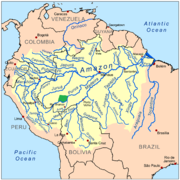
|
Size: Habitat: Area near the Inauini River Diet: |
LC
|
| Brown-mantled tamarin or Spix's saddle-back tamarin | Leontocebus fuscicollis (Spix, 1823) Four subspecies
|
Bolivia, Brazil and Peru.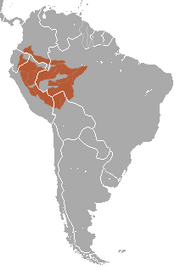
|
Size: Habitat: the Andes Mountains throughout the Amazon River Basin, they tend to inhabit primary and secondary lowland tropical forests. Diet: |
LC
|
| Lesson's saddle-back tamarin | Leontocebus fuscus (Pucheran, 1845) |
Peru (Amazonas) | Size: Habitat: Diet: |
NT
|
| Illiger's saddle-back tamarin | Leontocebus illigeri (Lesson, 1840) |
Colombia (Plaines de Mocoa, Putumayo, between the Rio Putumayo and Rio Caqueta), Brazil | Size: Habitat: Diet: |
LC
|
| Red-mantled saddle-back tamarin | Leontocebus lagonotus (Jiménez de la Espada, 1870) |
Ecuador and Peru | Size: Habitat: Diet: |
LC
|
| Andean saddle-back tamarin | Leontocebus leucogenys (Gray, 1866) |
Peru (Huanuco) | Size: Habitat: Diet: |
LC
|
| Black-mantled tamarin | Leontocebus nigricollis (Spix, 1823) Three subspecies
|
western Brazil, southeastern Colombia, north-eastern Peru and eastern Ecuador.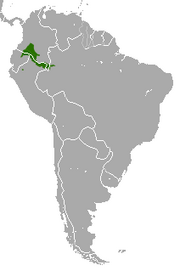
|
Size: Habitat: Diet: |
LC
|
| Geoffroy's saddle-back tamarin | Leontocebus nigrifrons (I. Geoffroy Saint-Hilaire, 1850) |
Peru | Size: Habitat: Diet: |
LC
|
| Golden-mantled tamarin or Golden-mantled saddle-back tamarin | Leontocebus tripartitus (Milne-Edwards, 1878) |
Ecuador and Peru(Amazon), Ecuador, and Northeast Peru (between the Rio Curaray and Rio Napo). | Size: Habitat: Diet: |
NT
|
| Weddell's saddle-back tamarin | Leontocebus weddelli (Deville, 1849) Three subspecies
|
Brazil, Bolivia and Peru | Size: Habitat: Diet: |
LC
|
In some locations saddle-back tamarins live sympatrically with tamarins of the genus Sanguinus, but the saddle-back tamarins typically occupy lower strata of the forest than do the Sanguinus species.[1] Saddle-back tamarins have longer and narrower hands than Sanguinus species, possibly adaption to differing foraging behavior, as saddle-back tamarins are more likely to search for insects that are hidden in knotholes, crevices, bromeliad tanks and leaf litter, while Sanguinus species are more likely to forage for insects that are exposed on surfaces such as leaves or branches.[1]
References
- ↑ 1.0 1.1 1.2 Rylands, Anthony B.; Eckhard W. Heymann; Jessica Lynch Alfaro; Janet C. Buckner; Christian Roos; Christian Matauschek; Jean P. Boubli; Ricardo Sampaio et al. (2016). "Taxonomic Review of the New World Tamarins (Primates: Callitrichidae)". Zoological Journal of the Linnean Society 177 (4): 1003–1028. doi:10.1111/zoj.12386. http://socgen.ucla.edu/wp-content/uploads/2016/02/Rylands-et-al-Review-of-tamarin-taxonomy-J-Zool-Linn-Soc-2016.pdf. Retrieved 2020-04-19.
- ↑ Buckner, JC; Lynch Alfaro, JW; Rylands, AB; Alfaro, ME (2015). "Biogeography of the marmosets and tamarins (Callitrichidae)". Mol Phylogenet Evol 82 Pt B: 413–425. doi:10.1016/j.ympev.2014.04.031. PMID 24857784.
- ↑ Gardner, Alfred L., ed (1 March 2008). Mammals of South America, Volume 1: Marsupials, Xenarthrans, Shrews, and Bats. University of Chicago Press. ISBN 978-0-226-28240-4. OCLC 644361912. https://books.google.com/books?id=dbU3d7EUCm8C.
- ↑ Garbino, Guilherme S.T.; Martins-Junior, Antonio M.G. (2018). "Phenotypic evolution in marmoset and tamarin monkeys (Cebidae, Callitrichinae) and a revised genus-level classification". Molecular Phylogenetics and Evolution 118: 156–171. doi:10.1016/j.ympev.2017.10.002. PMID 28989098.
- ↑ "Leontocebus Wagner, 1840". ITIS. https://www.itis.gov/servlet/SingleRpt/SingleRpt;jsessionid=ED3257EE744E9CF71560EA569B3E0746?search_topic=TSN&search_value=943882#null. Retrieved 2020-04-19.
- ↑ "Leontocebus". American Society of Mammalogists. https://mammaldiversity.org/#bGVvbnRvY2VidXMrJmdsb2JhbF9zZWFyY2g9dHJ1ZSZsb29zZT10cnVl. Retrieved 2020-04-19.
Wikidata ☰ Q25384537 entry
 |

